Last week I published the report on designer layoffs, this week I want to take a look at the other side — why do designers leave? It’s the second iteration of last year’s report but with additional data and insights.
My new online course UX Buddy helps designers create their UX portfolio, find, and get an awesome UX design job with a UX/design-mature company. It’s now live and enrolment is open for a couple more days. Check it out!
Not surprisingly, the layoffs were the biggest reason why designers lost their jobs in 2023. Compared to 2022, where only a fraction of them stated that they were let go, 14.3% of this year’s participants said they were laid off.
293 designers responded to my survey which is almost double compared to last year’s 159. I also added more questions to the survey. Last year I only asked about the main reason for quitting their job, this year I also asked them how much they increased their salary with their job switch, what the design maturity of the company they left was, about the company and design team size, and their happiness with the work, coworkers and their manager.
49.5% of respondents were UX/Product designers (Fig 1) and the majority, 23.3% of them, were from the United States (Fig 2). Take a look at the full breakdown in the charts below.

I recruited the participants through my mailing list and LinkedIn and I feel that they’re a good representation of the industry.
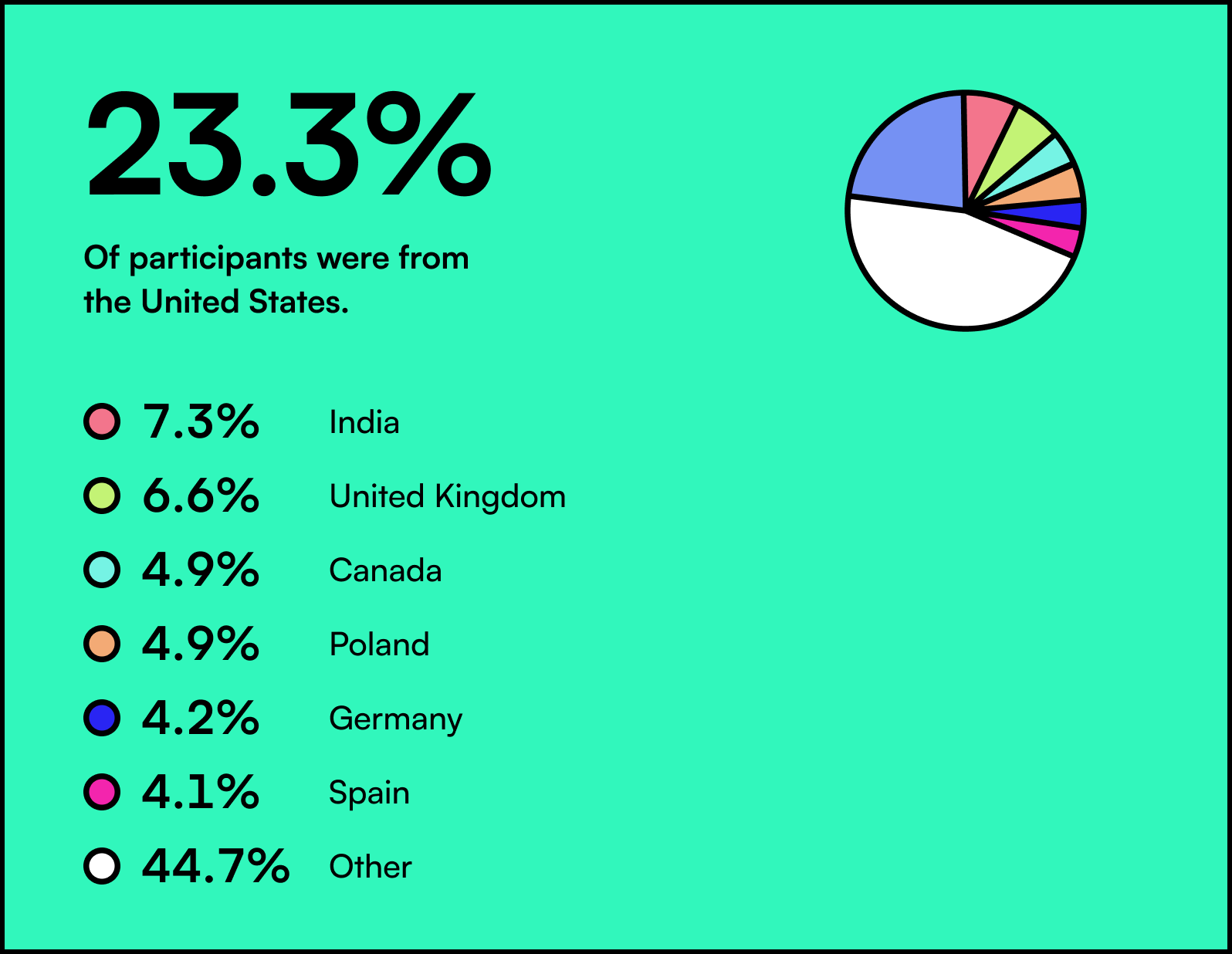
I asked the following questions in the survey:
- What was the main reason you left your last job?
- By how much did you increase your salary with the latest job switch?
- How would you rate the UX/Design maturity of the company?
- What was the size of the company?
- What was the size of the design team?
- How many years of experience did you have when you left?
- For how many years have you been with the company when you left?
- I was happy with the work I was doing (rate 1 to 5)
- I was happy with my coworkers (rate 1 to 5)
- I was happy with my manager (rate 1 to 5)
Participants could only pick one answer from a range of options. I know, even from my own experience, that there are usually multiple reasons why designers quit a job. And despite receiving a lot of feedback on last year’s survey calling for allowing multiple answers, I decided to keep the single-answer format because I wanted to learn about the most pressing reason.
Seniority distribution
The seniority distribution is interesting again as there are some major differences from 2022. First of all, something I noticed is that a lot of designers are still quite senior. 34.5% of them were senior, and 25.5% of them were either Staff, Principal, Lead, Manager or Head of Department. See the chart below for the full breakdown (Fig 3).
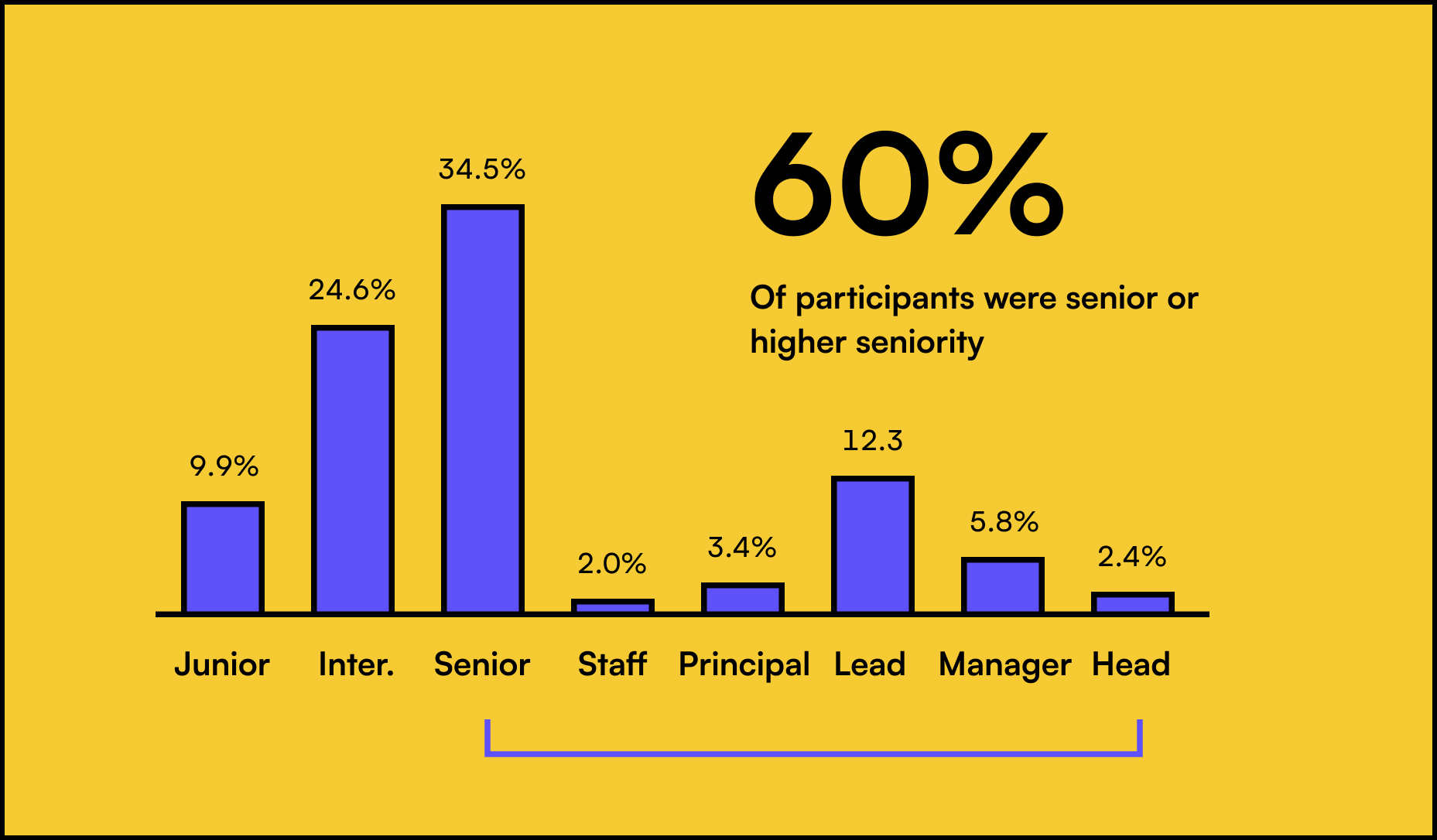
This leads me to believe that the UX industry is still top-heavy. Here’s something fascinating — compared to last year we see an increase in seniority overall. We see a major shift in intermediate (a decrease from 32.9% in 2022 to 24.6% in 2023) and senior designers (an increase from 27.7% to 34.5%). The junior and leads are comparable between the years.
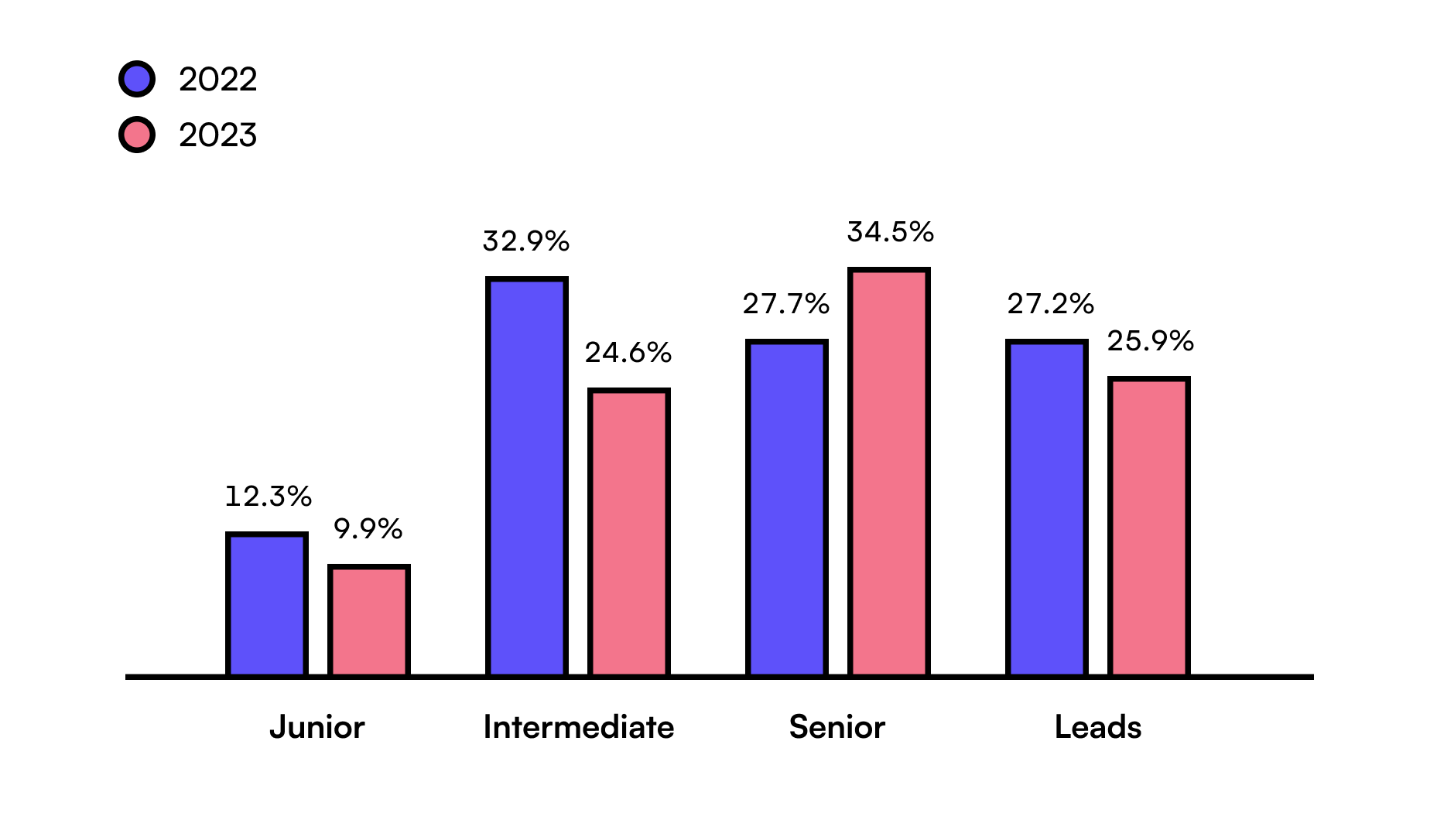
How can we explain that? Not only is the UX industry top-heavy, it’s actually getting heavier. A lot of intermediate designers are moving into senior roles but we don’t see major shifts from senior to lead roles. In fact, there was a decrease in lead roles compared to last year. This could mean that a lot of senior designers are still getting stuck in their careers as there are no career progression options for them where they work. As we’ll see later in the report, this is still one of the main reasons why designers quit their jobs. Let’s take a closer look at those.
Why do designers quit their jobs?
The first answer is, sadly, quite obvious — layoffs. Designers were amongst those who were hit the hardest in the tech layoffs of 2023. 14.3% of the respondents said they were laid off. Last year this answer wasn’t even an option so only a few of the 159 of last year’s respondents said they lost their job via the “Other” answer.
Not surprisingly, the layoffs had a huge impact on the other reasons. Being unhappy about the work they had to do received 10.2% of answers when it was 18.5% last year. The lack of career progression opportunities option was the second one (layoffs excluded) with 9.6%. Also a significant decrease compared to last year’s 18.5%. And finally, we have the low UX/Design maturity reason at 8.9%, compared to 11.5% from last year.
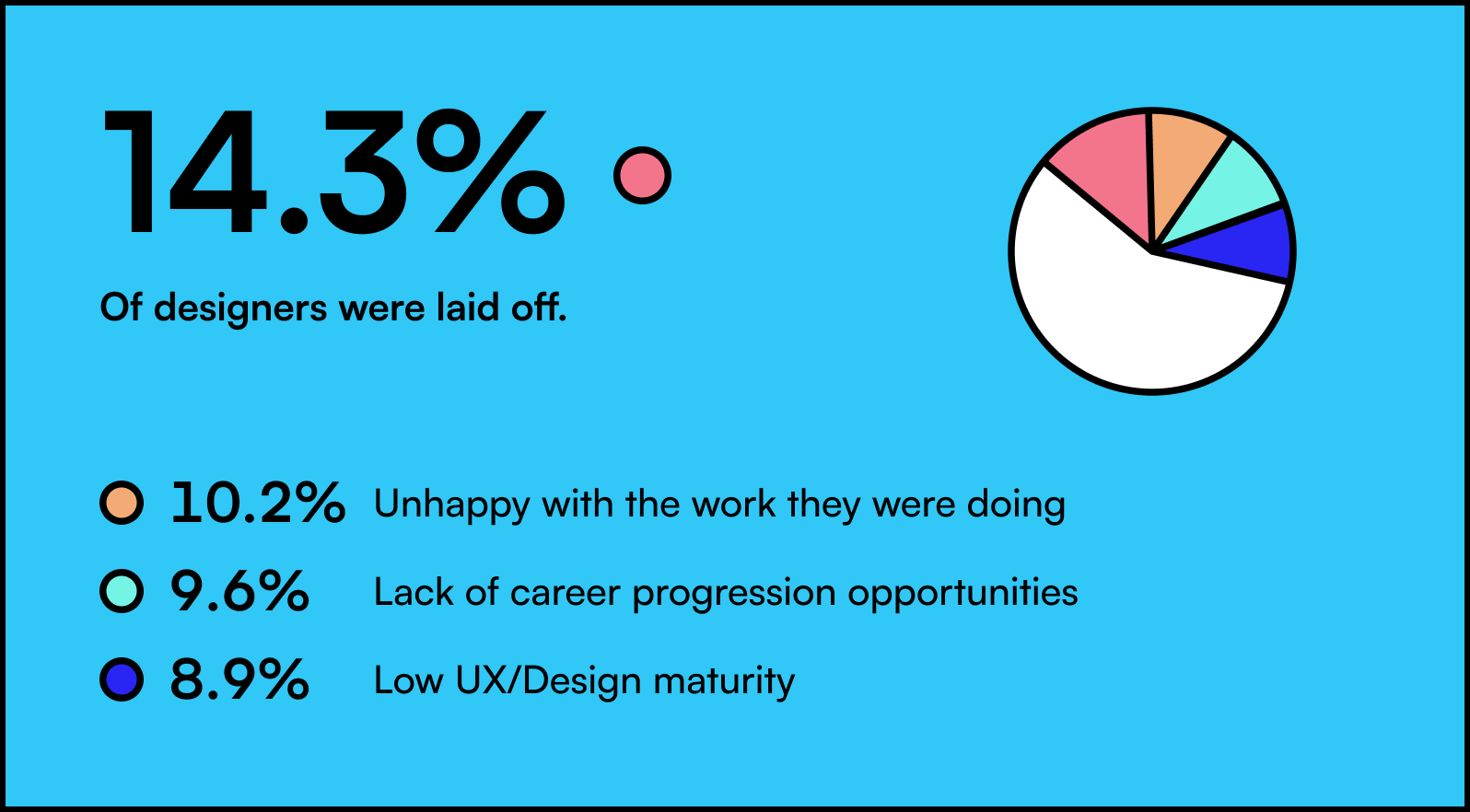
Excluding the layoffs, the top three reasons for designers quitting their jobs remain the same:
- Being unhappy about the work they do
- Lack of career progression opportunities
- Low UX/Design maturity
The unhappiness about the work and the lack of career progression saw significant changes in percentages but the problems with UX/Design maturity remain nearly the same.
Let’s dig in and take a closer look at the breakdown by seniority.
Junior designers feel they aren’t growing
17.2% of junior designers got laid off, only second to design leads at 19.3%. 13.8% of them quit because they felt they weren’t growing, and 10.3% lacked career progression opportunities. Only 6.9% of them were unhappy about the work they had to do, and an additional 6.9% of them were bothered by the low UX/Design maturity of the company.
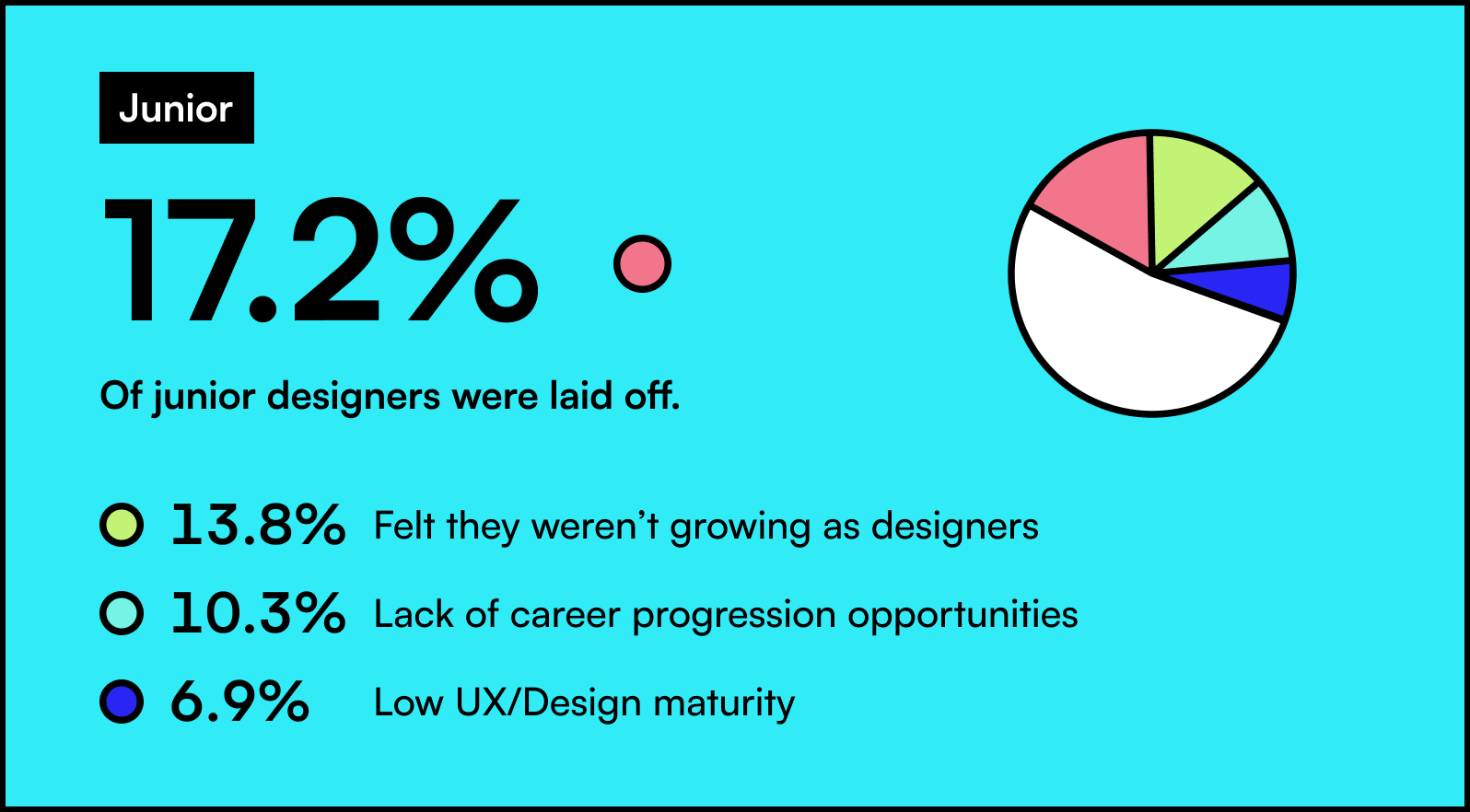
Excluding the layoffs, the stats are comparable to those from last year, especially the part where fewer of them are bothered by the low UX/Design maturity. It seems that growth and progress in their career are of higher priority, which makes sense as they’re at the beginning of their careers.
Intermediate designers lack career progression opportunities
One of the most surprising findings of this study is that only 8.2% of intermediate designers were laid off. Compared to others, who are all above 15%, that’s quite low. Is this the UX job market regulating itself? We saw a high demand for senior designers in the years leading up to 2023 so maybe companies “overhired” senior designers and now they’re trying to fix that.
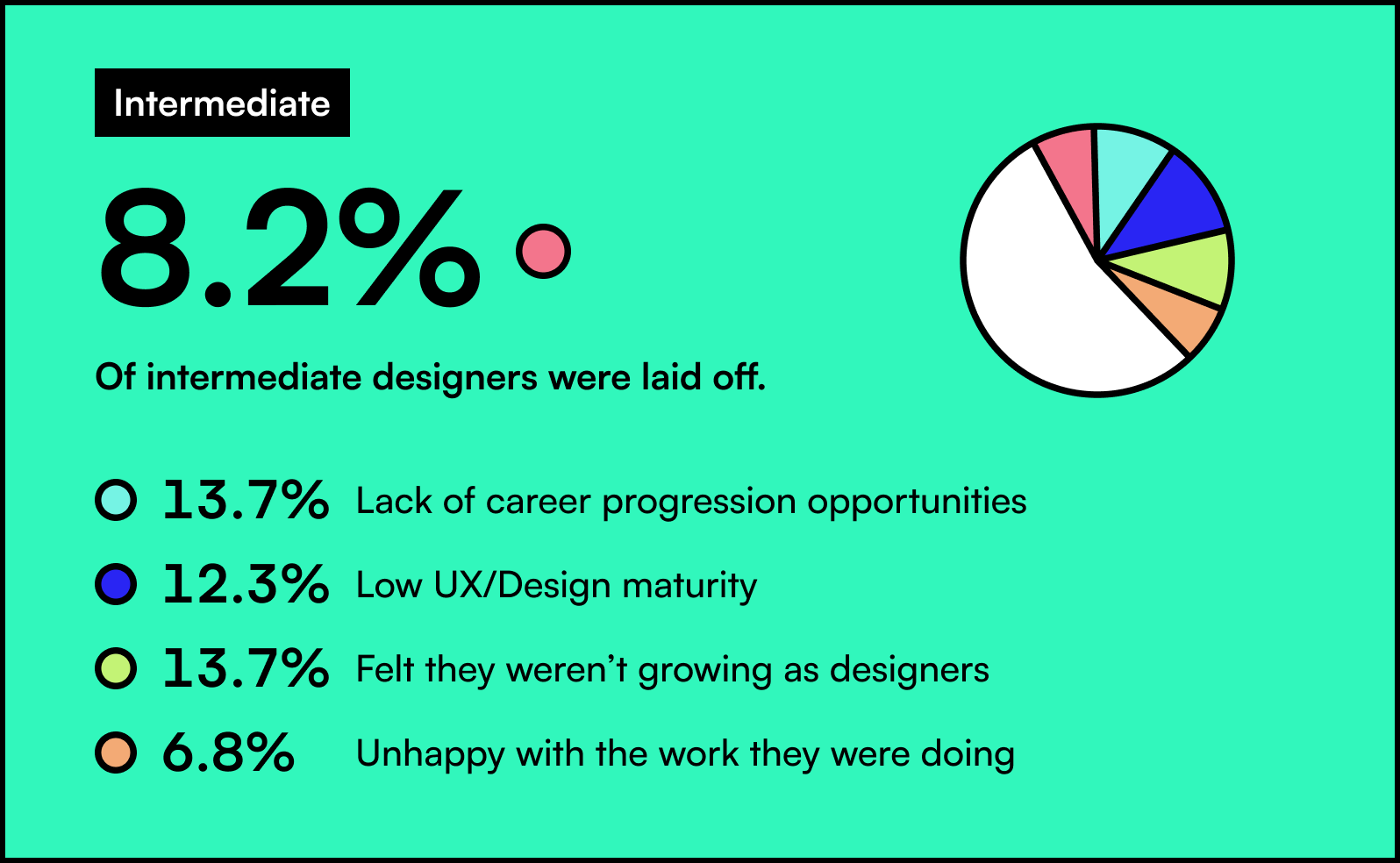
13.7% of them lacked career progression opportunities, and 12.3% of them were bothered by the low UX/Design maturity. It’s interesting to see how that isn’t that much of a problem for junior designers, becomes more problematic for intermediate and senior designers, but then drops again with the design leads.
I think that this pattern could indicate that the companies hiring intermediate and senior designers aren’t always mature enough to keep them. The presence of design leads may indicate a higher UX/Design maturity so that’s why it isn’t as much of a problem to them.
Senior designers and design leads are unhappy about the work they do
Senior designers are mostly unhappy with the work they have to do and are bothered by the low UX/Design maturity. 14.9% of them got laid off which seems to have impacted the major shifts we observed in the other answers. For example, only 10.9% of them were unhappy about the work they had to do, compared to 26.3% from last year. The low UX/Design maturity answer accounts for 9.9% this year, compared to 21.1% from last year.
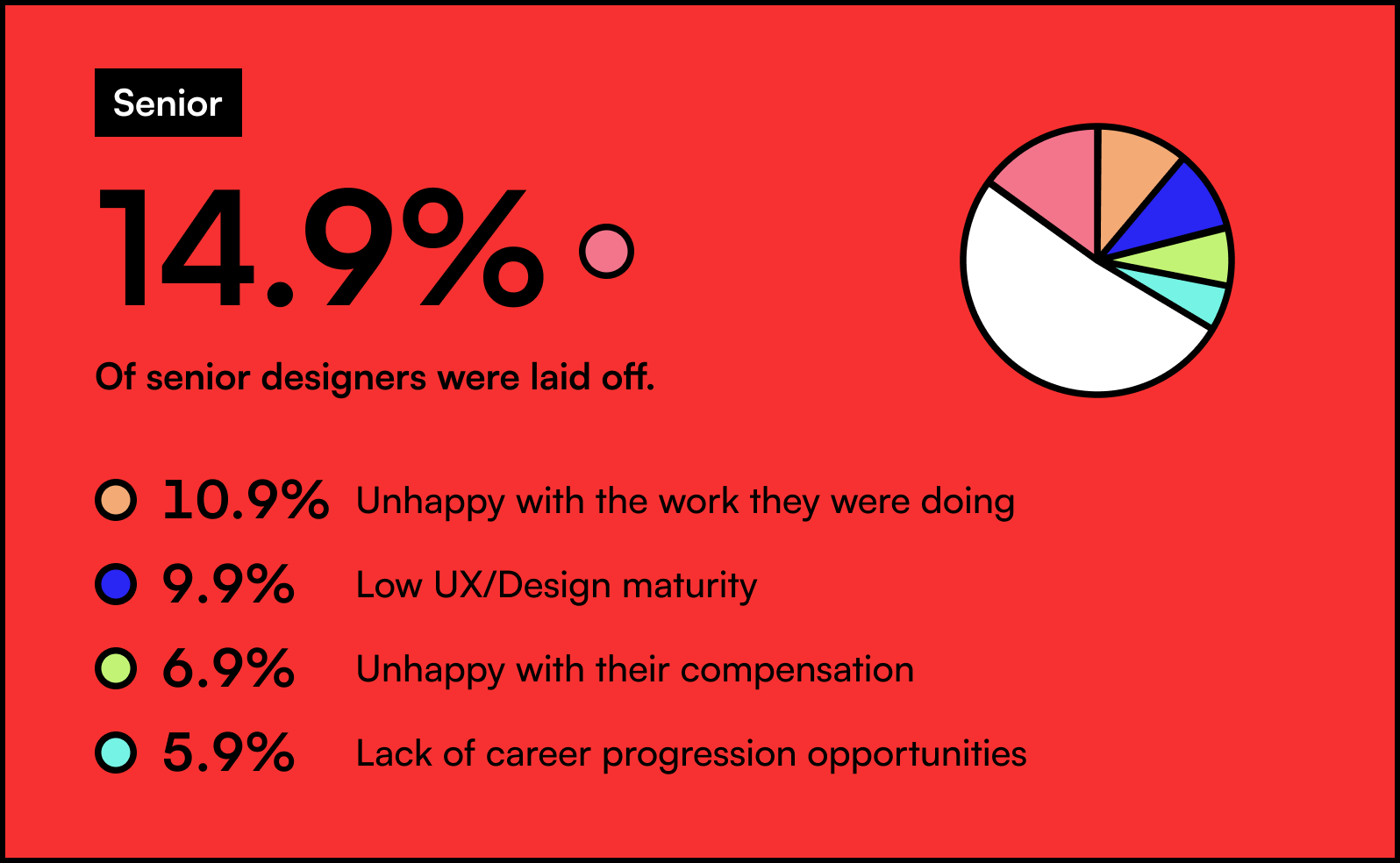
The biggest change comes with the lack of career progression opportunities reason where we see a decrease from 20.1% from last year to 5.9% in 2023. Senior designers are still unhappy about their compensation but there was a slight decrease compared to last year (6.9% in 2022 to 5.3% in 2023). They, along with design leads, are the only designers in my research who are unhappy with their compensation enough to quit their jobs.
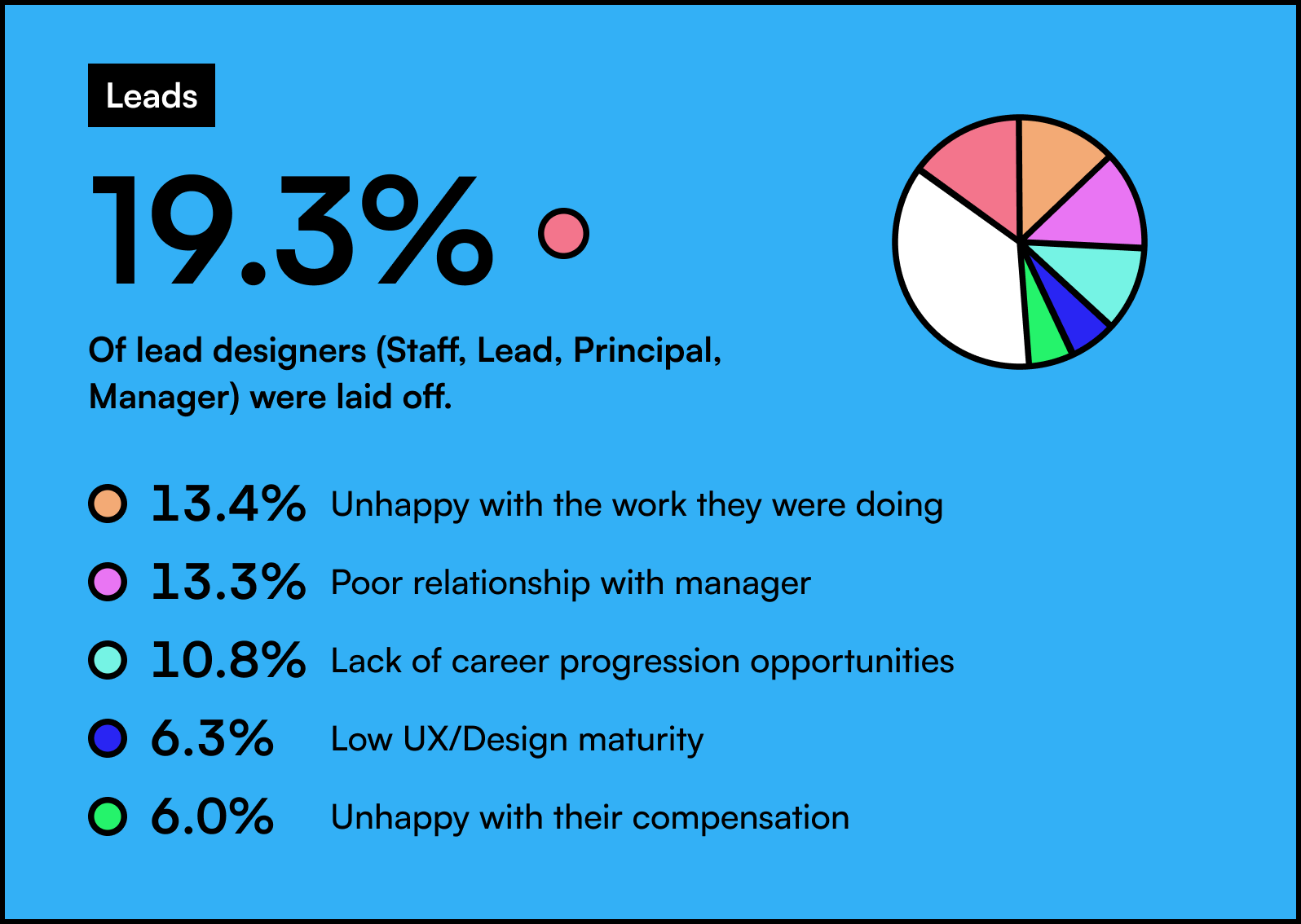
19.3% of design leads got laid off, the most out of all seniorities. That makes sense as they’re probably the most expensive employees. This could also be a sign of the UX job market and industry regulating and readjusting itself away from the inflated needs in the years 2020, 2021, and 2022.
Just like senior designers, design leads are also unhappy about the work they have to do. 13.4% chose this answer as the most pressing reason for quitting their jobs. However, there’s a significant decrease from last year, when 25% of them picked this answer. Interestingly, the UX/Design maturity is less of a problem to them as only 6.3% of them picked this answer.
Poor relationship with their manager is an answer that stands out when it comes to design leads. Far from being among the top three answers with other seniorities, 13.3% of design leads picked this as the main reason. This is quite comparable to last year’s 12.5%.
The last major change with design leads is with career progression opportunities. Only 10.8% picked this as the main problem this year, while 25% lacked career opportunities in 2022.
Generalists are still happier about the work they do and get recruited more
Conducting this report last year, I found that design generalists are generally happier with the work they do. I ascribed it to the work being more diverse, and more fun because of that. I wanted to check if this pattern still holds this year. Only 19 out of 293 designers who responded to the survey were generalists so take these stats with a pinch of salt.

15.8% of design generalists got laid off. But there’s an interesting spike in how many of them left because they got recruited by another company — 11% which is the most of all designers asked. Still, that’s only half compared to last year’s 22%. It’s probably the “layoff effect” we’ve witnessed with all other seniorities so far. They also seem to struggle with their managers as 10.5% of them said they left because of a poor relationship with them.
About 10% said they lacked career progression opportunities, and another 10% were bothered by the low UX/design maturity by their employers.
Design generalists are still happier with the work they do than other designers — only 5.3% of them left because of that reason. And there was a decrease compared to last year’s 11.1%.
Designers leave small teams and design-immature companies
Low UX/design maturity was one of the top three reasons in last year’s report so this year I decided to investigate this further. I asked designers what the maturity of the company they left was, based on NNG’s maturity levels. I linked to that page in the question so that designers could make an informed decision. The results are striking.
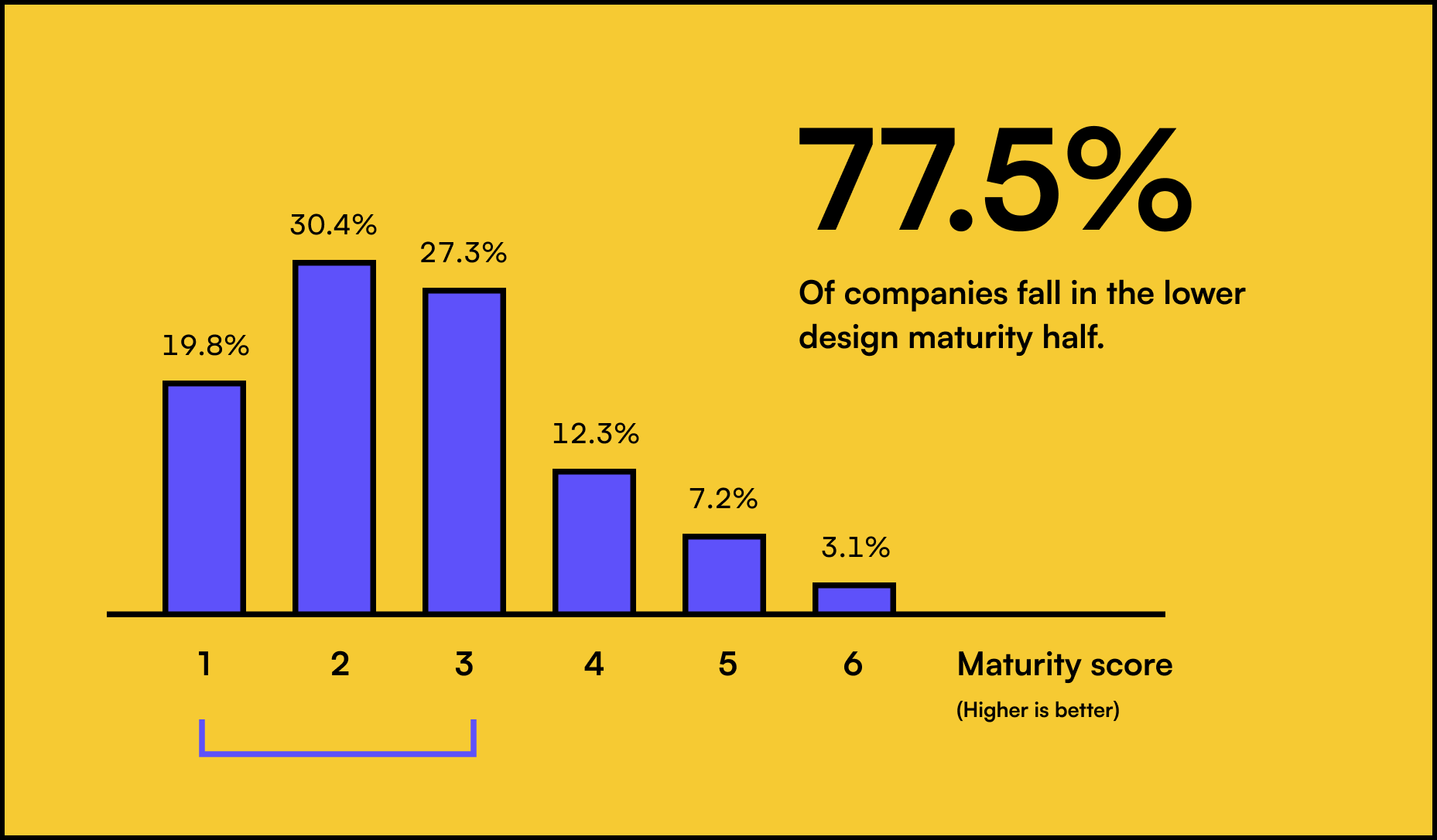
I like NNG’s levels of maturity because there’s no neutral option. If we divide the six levels in half we get the less mature companies (levels 1 to 3) and the more mature ones (levels 4 to 6). 77.5% of respondents evaluated the maturity of their companies with levels 1 to 3, meaning they’re more design-immature.
However we look at these results, UX/design maturity remains a huge problem in the UX industry. If this is in any way a reflection of it, most companies out there are still design-immature and we’ve made little to no progress in recent years. This finding leads me to think — can you think of anyone else working in tech who has to prove their value and justify their work? Engineers don’t have to prove the value of software development, product managers don’t have to justify product management. It’s only designers who are somewhat “expected” to prove their value and justify their worth. It’s only designers who have to work for design-immature companies who don’t understand what they do.
Ok, so designers leave design-immature companies. Let’s take a closer look at the company and team sizes that they leave behind. When looking at company sizes, the distribution is quite equal. Nothing stands out.
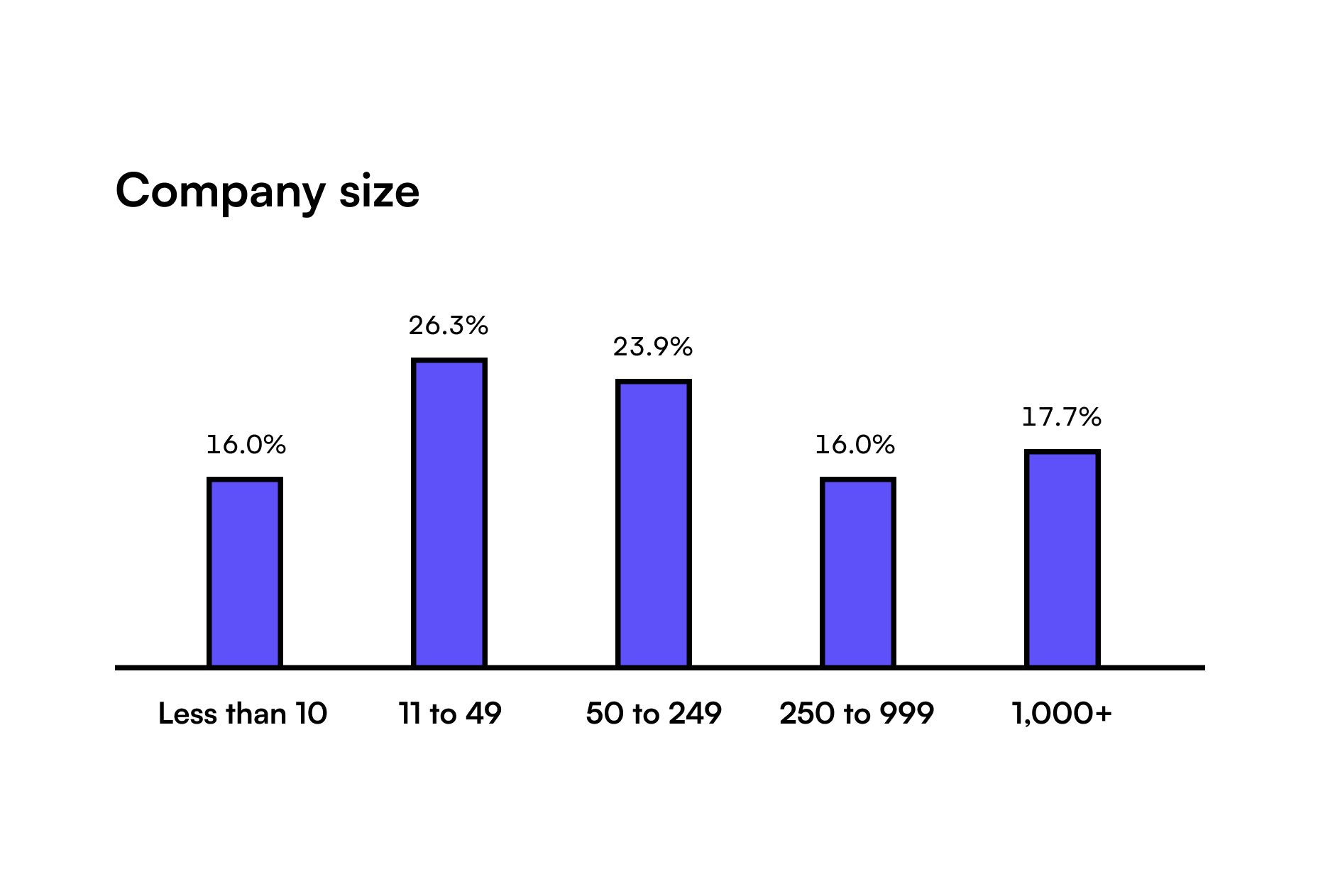
But when we look at design team sizes we get to some interesting stats. Designers mostly leave solo positions (22.2%) and small teams (34.8%). These stats may be a reflection of the state of the UX industry. There aren’t that many design teams out there with 20+ designers. I wouldn’t be surprised if most designers work alone and in small to medium-sized teams.
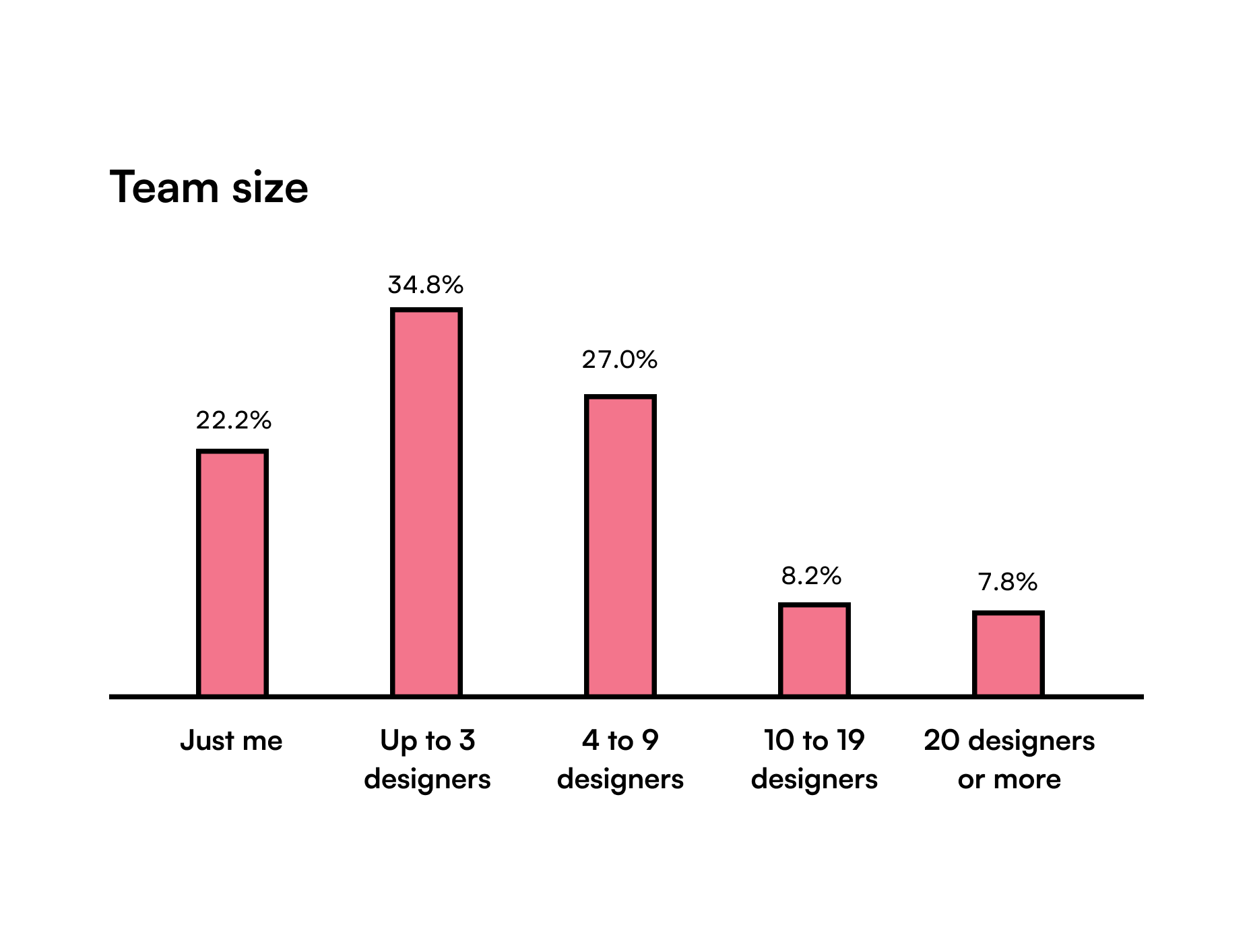
Looking at how many years of experience the designers had when they left we see that it’s mostly the experienced designers leaving.

When we look at how many years they’d been with the company a pattern emerges — most designers make it to three years with a company.
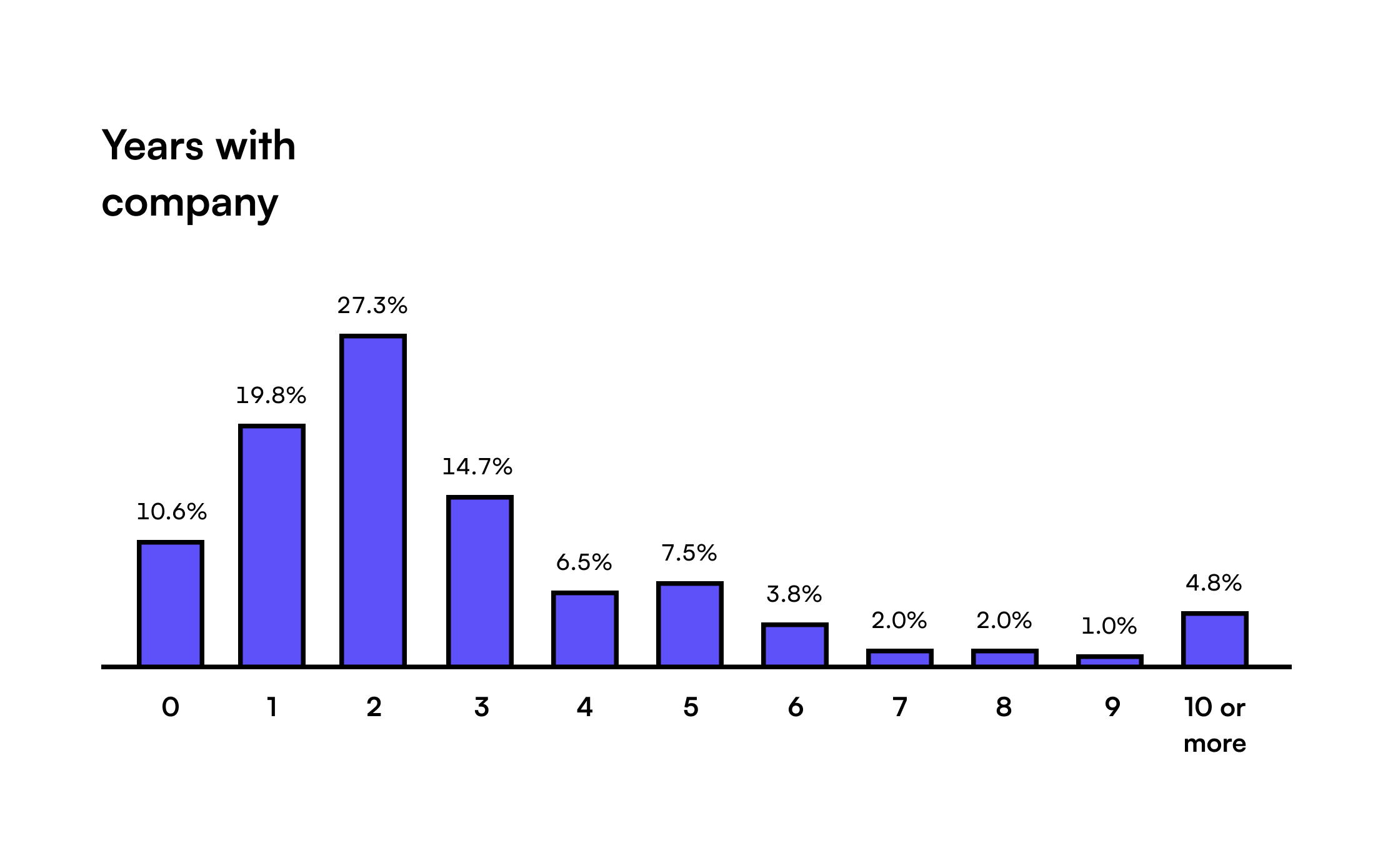
Designers are happy with their compensation but still get an average of 20% increase when switching jobs
Only 6% of participants claimed that they left their jobs because they were unhappy with their compensation. Still, when switching jobs, designers get 20%, 30% and even higher compensation increases. N/A (non-applicable) answers are mostly from the poor souls who got laid off. I’m surprised to see that 13.3% of them received no increase at all and that around 35% of them increased their salaries by less than 20%. Job switches are perfect for increasing one’s salary, but it seems that designers don’t know that.
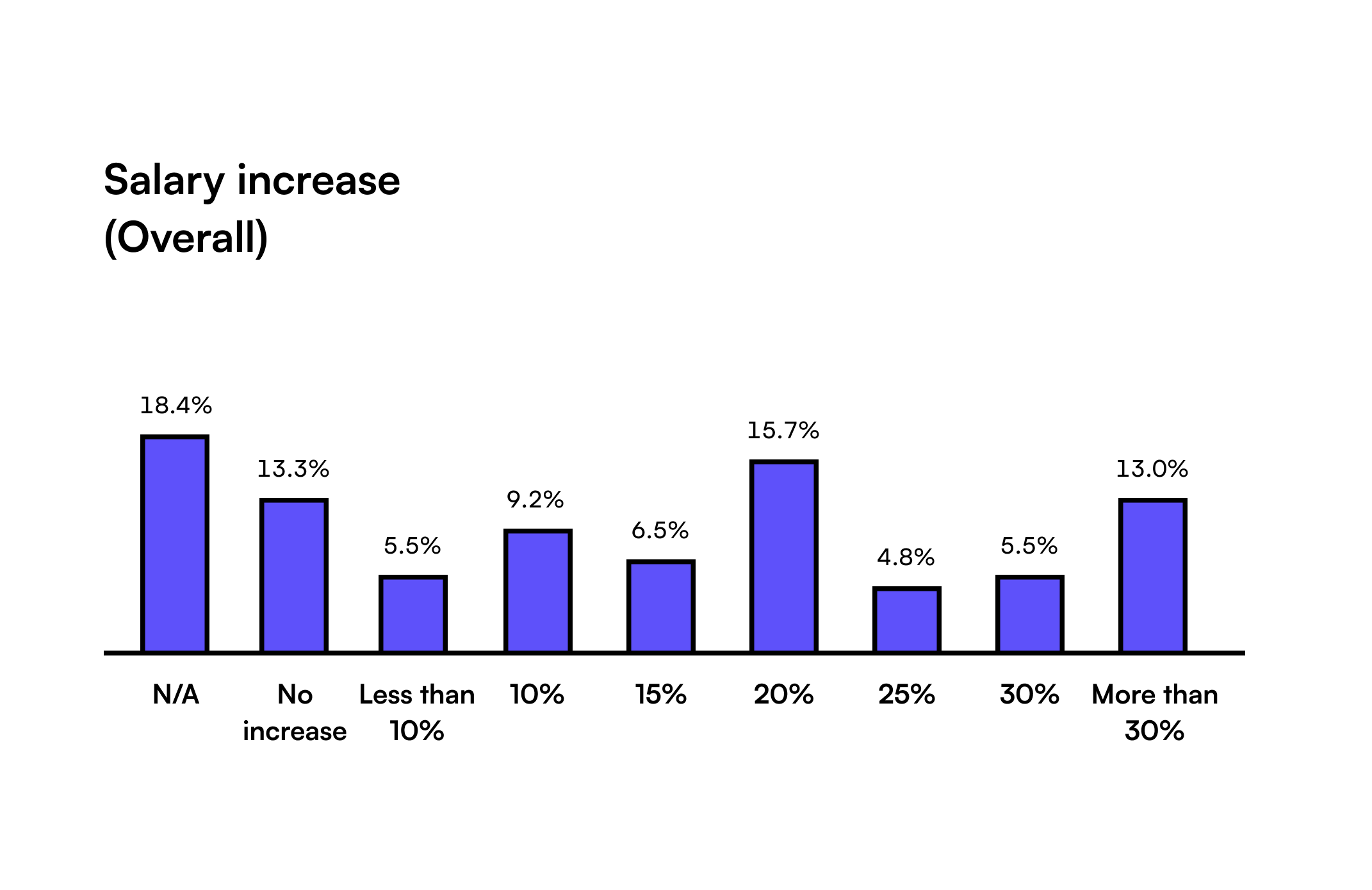
When we slice this data by seniority, we get to see some really interesting stats.
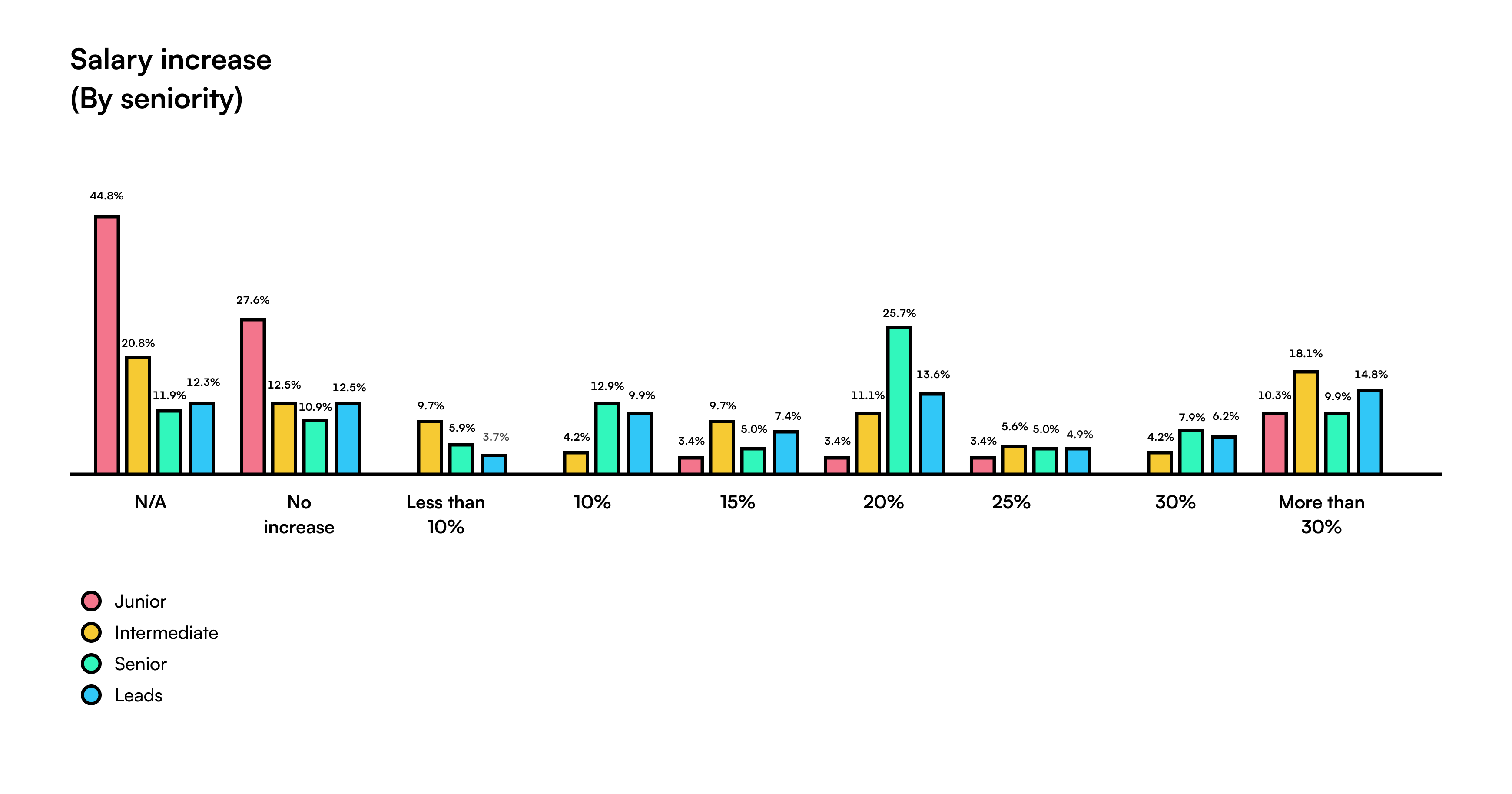
Junior designers only get minor increases or no increases at all. Intermediate generally get more than 30% increases (18.1% of them). Senior designers generally get 20% increases (25.7% of them), and the distribution is mostly equal for the design leads.
So intermediate designers get the most increases which isn’t that surprising at all as they’re in the middle steps of the corporate ladder with a lot of room and opportunities to advance. Senior designers also get significant increases, I’d argue mostly because they’re generally the most wanted.
Designers are unhappy with their managers but happy with their coworkers
Unhappiness with the work they do was, and still is, one of the biggest reasons why designers quit their jobs. So I wanted to take a close look this year, along with how satisfied they are with their managers and coworkers.
When asking about managers, I asked them how happy they were with them on a scale of 1 to 5 (1 being strongly disagree, 5 being strongly agree). “Happiness” can be quite a vague term so I added an explanation: “I felt supported and well guided.”
Only 25% of designers are happy with their managers. 19.1% feel neutral about them, and 56.8% of designers were unhappy with them.
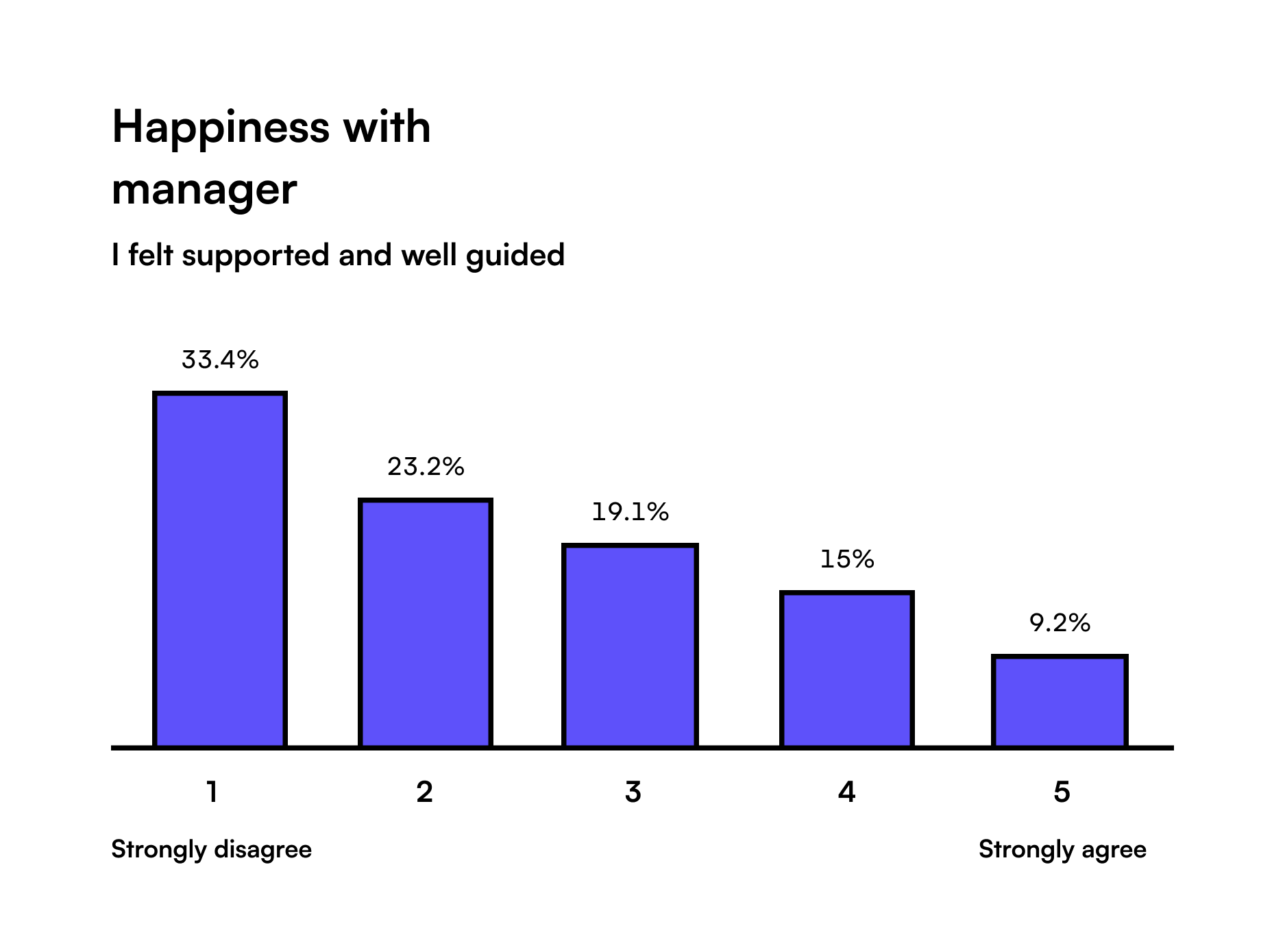
I expected a similar result when asking them about their happiness with their coworkers but found the opposite. The exact opposite actually. Most designers, 51.9% to be exact, are happy with their coworkers and only around 25% of them are unhappy. By “happy,” I explained that “They well understood and valued design and appreciated my work.”
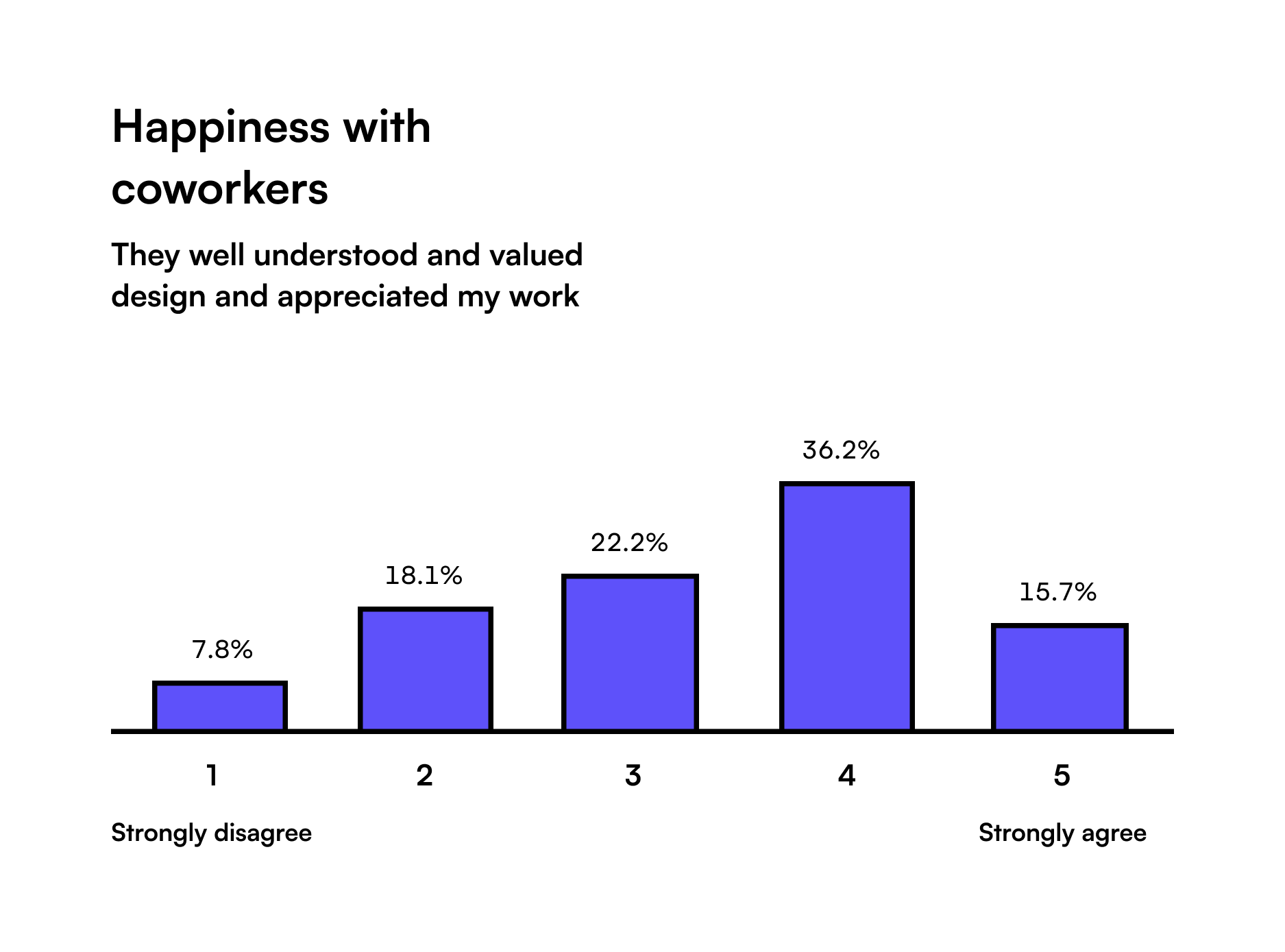
When asked about their happiness with the work they had to do, meaning that they felt “challenged and were growing as designers,” 47.4% of them felt unhappy. Only about 26% of them were happy with the work.
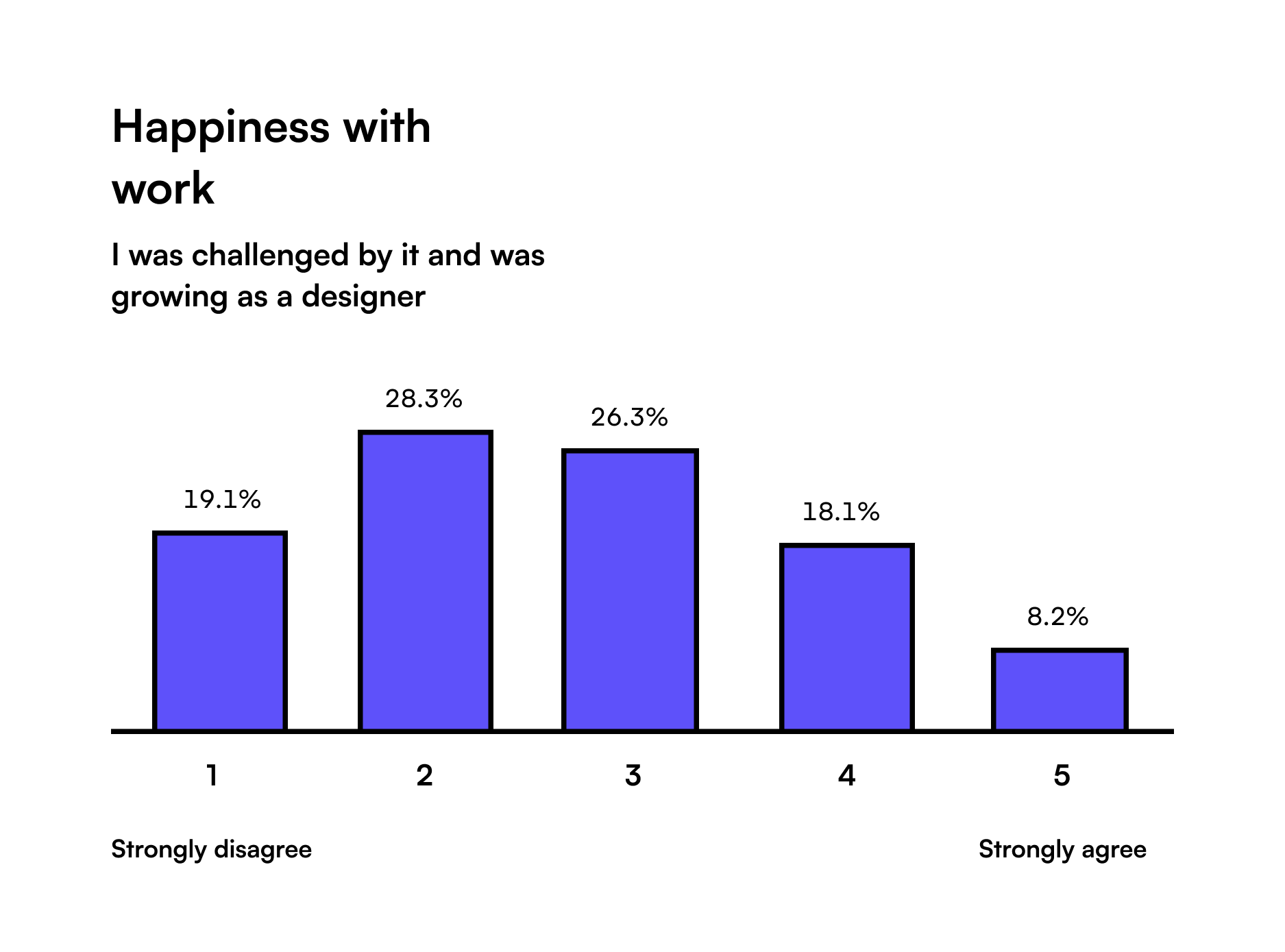
When it comes to remote work, 70% of designers can work remotely at least some of the time. Interestingly, the number of designers who left their jobs because remote work wasn’t a possibility is 3.1%, exactly the same as last year.

Conclusion
Last year, this was just a simple study with only three questions. I expanded it this year and found out that designers are generally unhappy with their managers and the work they have to do. UX/design maturity and no career progression opportunities are the major reasons for quitting their jobs. So when they leave, designers leave smaller teams and solo positions at design-immature companies. It’s mostly experienced designers doing the leaving and they do so after three years at a company.
This year we also witnessed a shift in seniority, a significant number of intermediate designers moved to senior positions, and 60% of designers were either senior or leads. The UX industry remains top-heavy and got a bit heavier in the last year, despite the layoffs. Speaking of which, it was mostly junior designers and design leads that got hit, intermediate designers being the safest. Generalists also got hit by the layoffs but also get recruited more often and are (still) generally happier with the work they do.
A few key findings to discuss: why are designers so unhappy with their work and their managers? Why does UX/maturity continue to be a problem in our industry? Why are most companies still design-immature and why do designers need to prove their value and justify their work? Let me know your thoughts in the comments, and I’ll pick one commenter randomly who’ll get a printed copy of my book and announce it here in the comments on December 14, 2023.
Another gentle nudge for my new course 😊 UX Buddy helps designers create their UX portfolio, find, and get an awesome UX design job with a UX/design-mature company. It’s now live and enrolment is open for a couple more days. Check it out!

These results really resonated with me and I could see myself in a lot of the findings. I’ve made it really clear that I wanted to take on more varied projects and grow my skillset as a designer but that is usually not taken seriously it seems when I get assigned work.
Besides my own efforts to continue learning and growing as a designer, I don’t feel like I learn much in my current role and I don’t feel confident that there are growth opportunities for me either.
A lot of the time the work is putting out fires, not solving the right problems, and then seeing my work not finished completely in development that drain me. Makes it pretty difficult to make case studies as well.
Thanks for sharing your story and opinion Alex! Unfortunately, it’s something i commonly hear from designers. It seems the UX as an industry got stuck in the immature stage and there seems to be no way out. Things probably got even worse in the last year or so…
I think a lot can be explained by David Graeber’s research. It’s worth reading his book “Bullshit Jobs” and a lot of things will become clear. Many of the arguments are well within the realm of UX design.
Thanks for the article, it adds to my view of working in different positions!
Thanks Oleg, that book has been on my to-read list for a while. I guess I need to get my copy now 🙂
Wow, this blog post on vehicle wrapping is incredibly informative! I’ve always been curious about how wraps can transform a vehicle, and this article covered everything from design tips to durability so well. I especially loved the section on customization – it’s amazing how wraps can make any vehicle look unique. I can definitely see how this could be a game-changer for businesses looking to advertise or anyone wanting to give their car a fresh new look. Thanks for sharing such great insights and practical advice!
At Don’t Drive Naked, we specialize in creating stunning vehicle wraps that not only catch the eye but also effectively convey your brand message. If anyone is considering a wrap, I highly recommend checking out our offerings at https://dontdrivenaked.com/ to see how we can help elevate your advertising game.